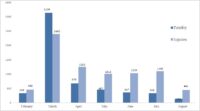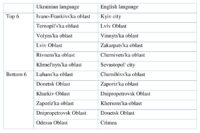By Sila Mishra
“…..The migration itself, like the pilgrimage, is the hard journey: a ‘leveller’ on which the ‘fit’ survive and stragglers fall by the wayside. The journey thus pre-empts the need for hierarchies and shows of dominance.”
(The Songlines)
The sites of deaths, collapsed walls, rubbles of kindergarten, shops, public utilities, and agricultural machines as well as Ukrainian students posing among the rubble whilst marking their graduation, demonstrate an unprecedented humanitarian crisis. The war that broke out on 24th February has ravaged the economy of Ukraine with a “freefall into poverty”. Ukrainian people are facing an estimated $349 billion repair cost for infrastructure and $252 billion for disruption in economic flows and production. (World Bank, 2022). Lasting for more than six months, the war in Ukraine has displaced numerous people, caused an unimaginable toll and pushed an entire generation on the brink of survival. More than 16 lakh refugees from Ukraine have registered themselves for temporary protection or similar national protection schemes and 1,707,455 refugees from Ukraine have been recorded in Hungary, Romania, Slovakia, Poland and the Republic of Moldova (UNHCR). Further, 7,536,433 refugees from Ukraine were recorded across Europe as of 30th September 2022 and 4,183,841 refugees from Ukraine registered for Temporary Protection or similar national protection schemes in Europe. To comprehend the lives on hold, following the first intentions survey, UNHCR conducted the second round of the survey and found that the majority of refugees intend to stay in their current host country because of safety and socio-economic issues in Ukraine. Given this backdrop and understanding the scarcity of migration data this article demonstrates how geo-referenced online search data (Google Trend Index, GTI) using both Ukrainian and English keywords can be used to examine the migration intention in Ukraine. This would facilitate real-time prediction of migration trends across the Ukraine regions.
The escalation in Ukraine has caused considerable damage in Ukraine, compelling people to displace from their homes, thus, making it a policy issue at a global level. Data on migration has the potential to aid in academic research, and effective policymaking. However, the huge cost associated with the collection of high-frequency nationally representative migration data and variability in the definitions of data sources across the world still pose an obstacle to migration research. Given this backdrop, to obtain high-frequency data on a real-time basis, Google Trends as shown by Choi & Varian (2012) could be a better indicator in ‘predicting the present’, considered as a form of ‘contemporaneous forecasting’ or ‘nowcasting’. Google Trends is a georeferenced online search data which has become increasingly important in applied economic research. Prior to using Google Trends to measure the perceived exposure to migration, from the World Bank statistics, it may be observed that there has been a significant surge in internet users, and internet connections in Ukraine (Table 1). It is also worth mentioning that before the crisis, there was an uptick in migration and remittances.
Table 1 Internet accessibility in Ukraine
| Variable | 2016 | 2017 | 2018 | 2019 | 2020 | |
| Individuals using the Internet (% of the population.) | 53.00 | 58.89 | 62.55 | 70.12 | 75.04 | |
| Secure Internet servers | 85755 | 177005 | 268976 | 349187 | 395092 | |
| Mobile cellular subscriptions (per 100 people) | 133.17 | 131.36 | 127.75 | 130.63 | 129.34 | |
| Fixed broadband subscriptions | 5125499 | 5239743 | 5405125 | 6784185 | 7769401 | |
Note: Data sourced from the World Bank
Google Trends Index

Author has used Google Trends to track the frequency of search terms for migration in Ukraine. The purpose ranges from the assumption that those who are considering migration are inclined towards consulting the internet before moving because it is less influenced by perceived societal judgements simultaneously protecting their anonymity and privacy. Google supplies insights on the intended trip and intention of the people from the place of origin to migrate. Further, these queries don’t even require high-level programming skills and record extremely high-frequency data and could be accessed virtually free. Though Ukraine has experienced migration in the past too, Google Trends supplies insights into the last 12 months’ Google search and interest across regions.
Table 2 List of keywords
| English | Ukrainian | English | Ukrainian |
| Applicant | Заявник | Nationality | Національність |
| Arrival | Прибуття | Naturalization | Натуралізація |
| Asylum | Притулок | Deportation | Депортація |
| Benefit | Вигода | Diaspora | Діаспора |
| Border control | Прикордонний | Earning | Заробіток |
| Business | Бізнес | Economy | Економіка |
| Citizenship | Громадянство | Embassy | Посольство |
| Compensation | Компенсація | Emigrant | Емігрант |
| Consulate | Консульство | Emigrate | Емігрувати |
| Contract | Договір | Passport | Паспорт |
| Customs | МИТНИЦЯ | Payroll | Нарахування |
| Emigration | Еміграція | Pension | Пенсія |
| Employer | Роботодавець | Quota | Квота |
| Employment | Працевлаштування | Reservation | Бронювання |
| Foreigner | Іноземець | Recession | Рецесія |
| GDP | ВВП | Recruitment | Вербування |
| War | Війна | Refugee | Біженець |
| Crisis | Криза | Remuneration | Винагорода |
| Hiring | Наймання | Required documents | Необхідні |
| Illegal | Незаконний | Salary | Зарплата |
| Immigrant | Іммігрант | Smuggler | Контрабандист |
| Immigrate | Іммігрувати | Smuggling | Контрабанда |
| Immigration | Імміграція | Tax | Податок |
| Income | Дохід | Tourist | Туристичний |
| Inflation | Інфляція | Unauthorized | Несанкціонований |
| Internship | Стажування | Undocumented | Бездокументований |
| Job | Робота | Unemployment | Безробіття |
| Labor | Праці | Union | Спілка |
| Layoff | Звільнення | Vacancy | Вакансія |
| Legalization | Легалізація | Visa | Віза |
| Migrate | Мігрувати | Waiver | Відмова |
| Migration | Міграція | Wage | Заробітна |
| Minimum | Мінімум | Welfare | Добробуту |
Note: English keywords borrowed from Böhme et al. (2020).
Ukrainian Keywords are derived from Google Translator being used for each English keyword.
The real-time monitoring of migration intentions through Google Trends for the past 12 months shows three-fold insights. Firstly, shortly after the unprovoked invasion in Ukraine on 24th February, there has been a surge in the Google search for the list of keywords presented in Table 2, indicating the uptick in the perceived exposure to migration. The trend seems to be rising in both English and Ukrainian language, however, it is prominent for Ukrainian keywords. Secondly, the trend of migration intention closely follows the fear arising from casualties and injuries recorded in Ukraine. As the casualties shot up in Ukraine (Refer to Figure 1), people’s intention to migrate also rose in the form of Google searches. This surge in searches for migration was repeated across the period following the unrest. Thirdly, over the last 12 months, the lowest-ever migration search was recorded on 27th February (Ukrainian language) and the highest was recorded on 25th September 2022. The variation across Google searched in English and the Ukrainian language isn’t much different (standard deviation hovering around 5) implying are less indifferent over the usage of these languages while searching for migration related keywords.
Google search for the list of keywords as reported in Table 3 across regions shows that people living in Kyiv city and Ivano-Frankivs’ka oblast have held the top spot in the interest-by-region list for the last 12 months in English and Ukrainian language the most. The minimum was recorded in Chernihivs’ka oblast and Luhans’ka oblast in English and Ukrainian language respectively.
Figure 1 Casualties recorded in 2022 due to the invasion

Note: Based on the information provided by the Office of The High Commissioner for Human Rights
Figure 2 Google search for the migration keywords in the English language

Figure 3 Google search for the migration keywords in the Ukrainian language

We find that following the invasion there has been a surge in Google Searches for keywords related to migration in the past 12 months in Ukraine which closely follows the casualties recorded (Figure 2 and Figure 3). From the policy perspective, this real-time data on migration intention could be used to deliver aid across regions in Ukraine in this humanitarian crisis. The study could be complemented with other tools to match the robustness of the prediction with the official statistics. It can improve the performance of conventional models of migration flows. Further, as shown by the earlier studies these data could be used for an interesting empirical test for future work to investigate the impact of an exogenous shock on migration-specific GTI and on migration flows in a region.
Table 3 Interest in migration search by region

The escalation in Ukraine has caused considerable damage in Ukraine compelling people to displace from their homes. Millions of vulnerable refugees who have crossed borders with their elderly parents, children, and differently-abled dependents are in dire need of aid at their origin and destination. In addition to the findings, it can be said that along with the support from inter-government agencies, this volatile and unpredictable situation in Ukraine demands data-driven policy formulation which could be made possible with the assistance of real-time big data. Therefore, any effort in this direction should be a welcome step.
References
Böhme, M. H., Gröger, A., & Stöhr, T. (2020). Searching for a better life: Predicting international migration with online search keywords. Journal of Development Economics, 142, 102347.
Chatwin, B. (2016). The songlines. Open Road Media
Choi, H., & Varian, H. (2012). Predicting the present with Google Trends. Economic Record, 88, 2-9.
The World Bank, https://www.worldbank.org/en/news/press-release/2022/09/09/ukraine-recovery-and-reconstruction-needs-estimated-349-billion
UNHCR, https://data.unhcr.org/en/situations/ukraine/location?secret=unhcrrestricted
UNHCR, https://data.unhcr.org/en/documents/details/95767

Sila Mishra is a research scholar in the Department of Economic Sciences at IIT-Kanpur and her research interest primarily lies in Applied Microeconomics.
